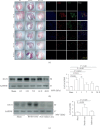Kynurenic Acid Is a Predictive Prognostic Metabolic Marker in ST-Elevation Myocardial Infarction
- PMID: 40709077
- PMCID: PMC12289359
- DOI: 10.1155/cdr/9123654
Kynurenic Acid Is a Predictive Prognostic Metabolic Marker in ST-Elevation Myocardial Infarction
Abstract
Background: The tryptophan/kynurenic acid (KYNA) pathway plays a crucial role by modulating inflammation, oxidative stress, and immune activation. The clinical value of tryptophan metabolites in the KYNA pathway for the early diagnosis and prognosis of STEMI patients, as well as the underlying functional mechanisms, remains to be elucidated. Objectives: This study evaluated the prognostic value of KYNA, a metabolite of the tryptophan pathway, in STEMI patients. Methods: Untargeted metabolomics by 1H-nuclear magnetic resonance (NMR) analysis was used to examine metabolite changes between 50 control subjects and 50 STEMI patients with an onset time of < 3 h. Furthermore, targeted metabolomic analysis was employed to investigate the association between KYNA and the prognosis of STEMI patients by LC-Q-TOF MS analysis. Results: Fifteen differential metabolites were identified between STEMI patients and control subjects by 1H-NMR analysis. KYNA as an important metabolite upregulated obviously in the tryptophan pathway was 337.67 nmol/L in STEMI patients (interquartile range: 241.16-500.29 nmol/L). In addition, KYNA was significantly associated with major adverse cardiovascular events (MACEs) (HR: 5.95, 95% CI: 2.03-17.44; p = 0.0012) and all-cause mortality (HR: 7.11, 95% CI: 1.52-33.29; p = 0.013) and showed moderate predictive value for 12-month MACE (area under the curve (AUC) = 0.72, 95% CI: 0.65-0.80) and all-cause mortality (AUC = 0.74, 95% CI: 0.65-0.83). KAT1 expression was upregulated in infiltrating macrophages of thrombus tissue coming from the culprit coronary artery of STEMI patients. KAT1 upregulation was also observed in macrophages located within the peri-infarct myocardium. Conclusions: The KYNA level may correspond to the underlying status of acute myocardial infarction and is a promising biomarker for predicting STEMI progression.
Keywords: NMR; ST-acute myocardial infarction; kynurenic acid; metabolic marker; prognostic.
Copyright © 2025 Xiaolin Zhang et al. Cardiovascular Therapeutics published by John Wiley & Sons Ltd.
Conflict of interest statement
The authors declare no conflicts of interest.
Figures







Similar articles
-
Complete versus culprit-only revascularisation in ST elevation myocardial infarction with multi-vessel disease.Cochrane Database Syst Rev. 2017 May 3;5(5):CD011986. doi: 10.1002/14651858.CD011986.pub2. Cochrane Database Syst Rev. 2017. PMID: 28470696 Free PMC article.
-
Apelin-to-total cholesterol ratio predicts long-term major adverse cardiovascular events in ST-elevation myocardial infarction patients after primary percutaneous coronary intervention: a retrospective cohort analysis.BMC Cardiovasc Disord. 2025 Jul 4;25(1):478. doi: 10.1186/s12872-025-04949-5. BMC Cardiovasc Disord. 2025. PMID: 40615939 Free PMC article.
-
The comparative and added prognostic value of biomarkers to the Revised Cardiac Risk Index for preoperative prediction of major adverse cardiac events and all-cause mortality in patients who undergo noncardiac surgery.Cochrane Database Syst Rev. 2021 Dec 21;12(12):CD013139. doi: 10.1002/14651858.CD013139.pub2. Cochrane Database Syst Rev. 2021. PMID: 34931303 Free PMC article.
-
Comparing FFR-Guided Complete Revascularization and Conservative Management for Non-Culprit Lesions in STEMI Patients With Multivessel Disease: A Systematic Review and Meta-Analysis.Catheter Cardiovasc Interv. 2025 Feb;105(3):633-642. doi: 10.1002/ccd.31379. Epub 2024 Dec 24. Catheter Cardiovasc Interv. 2025. PMID: 39718185
-
Myocardial MRI Cine Radiomics: A Novel Approach to Risk-Stratification for Major Adverse Cardiovascular Events in Patients With ST-Elevation Myocardial Infarction.J Magn Reson Imaging. 2025 Aug;62(2):430-443. doi: 10.1002/jmri.29739. Epub 2025 Feb 11. J Magn Reson Imaging. 2025. PMID: 39932202
References
MeSH terms
Substances
LinkOut - more resources
Full Text Sources
Medical

